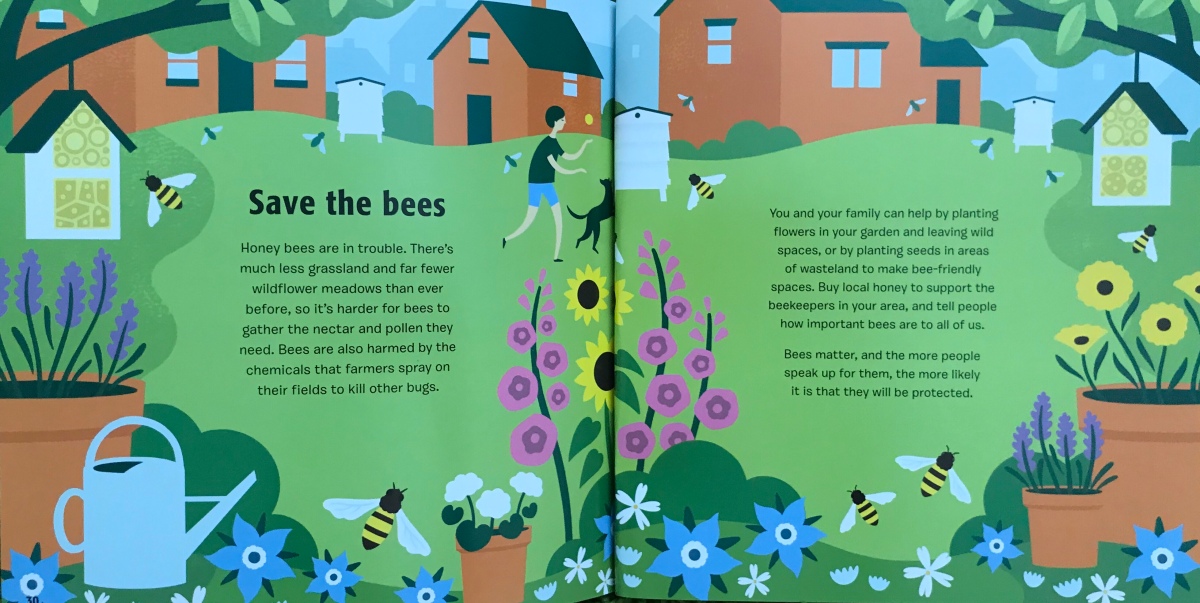This week we’re reading three beautifully illustrated picture books full of fascinating information about bugs!

The Big Book of Bugs by Yuval Zommer
The Big Book of Bugs by Yuval Zommer (Thames & Hudson; ages 5-8) is an oversized picture book with spreads dedicated to 8 specific bug-related topics (e.g. bug family tree), 18 individual types of bugs (e.g. dragonflies, earthworms), a glossary, an index, and the key to numerous spotting challenges peppered throughout. The facts contained within are nestled in fantastic illustrations and range from the broadly known (e.g. butterflies drink nectar) to the absolutely surprising (e.g. a tropical giant centipede eats BATS!). The overall organization makes it easily parsed into multiple reading sessions for younger children and the full-page illustrations are packed with detail worth lingering over. Overall, it’s a gorgeous, informative and captivating book that’s as good for science lessons as it is for awing and entertaining kids of all ages. I haven’t read the others in this series (The Big Book of Beasts
and The Big Book of the Blue
), but I can’t wait to get my hands on them!

BUG FAMILY TREE Are all bugs the same? Not at all! Bugs come in different types, or families. Here’s how to tell who’s who. Insects have… ….a body in three parts …six legs …two, four or no wings …feelers Snails and slugs have… …one squishy “foot” for sliding along …feelers …a shell that keeps a snail safe …the scientific name “gastropods” Can you find… …two stick insects? Here’s a clue — they look like thin twigs. Spiders have… …eight legs …no wings …a body in two parts ….the scientific name “arachnids” Centipedes and millipedes have… …lots of legs …a body made of a head plus many rings, or segments …feelers …the scientific name “myriapods” Worms have… …no legs …a long bendy body …a mouth at one end …the scientific name “annelids”

ANTS Why do ants march in a line? Because each ant follows the one in front. Thousands of ants share a nest. They work to keep the nest clean and safe and to bring back food. An ant talks with its feelers An ant taps its long feelers on the other ants to pass on a message Ants follow smelly trails… …left by other ants to find food to take back to the nest. The queen lays many eggs She is the mother of all the ants in the nest. Most ants live for 90 days but the queen ant can live for 15 years!

CENTIPEDES Does a centipede really have 100 legs? Not always. Most centipedes have about 30 legs, but some have more than 300! A centipede marches along quickly on its legs. Up, two, three, four… A centipede has a bendy body It has one pair of legs on each segment, or part, of its body. Home is dark and damp A centipede lives under leaves and logs. It needs to keep its body dam. How big is a giant centipede? As big as a dinner plate. A tropical giant centipede eats frogs, birds and even bats. Centipedes are very old They lived on Earth long before dinosaurs appeared.

SNAILS Just how slow does a snail go? Super slow! It would take a snail about one day to slither to the end of a long garden A snail can see and sniff A snail has four bendy feelers. Two long feelers have eyes on the tips. Two shorter feelers sniff things to eat. A shell is a safe home But watch out! A bird might smash the shell and eat the snail inside. Snails live in wet places They leave a slimy trail, which helps them to glide along. A snail lays eggs Baby snails hatch out. As the snail grows, the shell grows too.

The Amazing Life Cycle of Butterflies by Kay Barnham, illustrated by Maddie Frost
The Amazing Life Cycle of Butterflies by Kay Barnham, illustrated by Maddie Frost (Barron’s Educational Series, ages 8-12) guides readers through each stage of a butterfly’s life cycle in a beautiful picture book format with writing perfectly suited to a classroom setting. The information is sufficiently detailed to be engaging but presented concisely and with language appropriate for the target audience. Colorful illustrations are done in Maddie Frost’s charming and playful style while also integrating beautifully realistic representations of many butterfly varieties. The last pages are dedicated to a review of the life cycle stages (excellent for enhancing comprehension and retention of the material) and a discussion about how to combat butterfly endangerment in your own garden. It then closes with pages about Things to Do and Notes for Parents and Teachers filled with ways to extend learning beyond the picture book. A list of recommended books, which would be perfect accompaniments for a complete lesson plan, make this a gem for educators.
My children and I love this book and the entire Look and Wonder series (which also includes A Stroll Through the Seasons, The Amazing Life Cycle of Plants
, and The Great Big Water Cycle Adventure
) so much that we read them often. And my daughter has taken the information about butterflies to heart so much that she has become a fierce protector of our lavender plants! I plan to feature the remaining three in future posts; in the meantime, you can read more about Maddie Frost’s illustration work in my interview with her here. Enjoy!

A butterfly begins its life as a tiny egg. Some eggs are round, some are oval, and some have ridges. The female butterfly sticks her eggs onto leaves or stems, very close together. This plant will soon become food.

A butterfly has four wings. These are covered with millions of tiny, colored scales, which create different patterns. Some wing patterns allow butterflies to hide. Others have special markings that look like big eyes to scare away enemies. Bold, bright colors attract mates.

Caterpillars have many enemies. They are gobbled up by birds, wasps, and ladybugs. In some countries, humans eat them, too. Caterpillars use bristles, spikes, smells, and poison to frighten away enemies. Sometimes they disguise themselves with eyespots and patterns. This caterpillar is pretending to be a snake!

Did you know that butterflies are in danger? Pesticides cause them harm, and there are fewer wildlife areas for them to visit. Soon, many species may become extinct. You can help by planting flowers such as buddleia, verbena, and lavender in a sunny, sheltered spot. Then, wait for butterflies to appear!

Being a Bee by Jinny Johnson, illustrated by Lucy Davey
Being a Bee by Jinny Johnson, illustrated by Lucy Davey (Barron’s Educational Series, ages 5-8) is a comprehensive and fascinating review of bees and their intersection with humans. There are 12 chapters dedicated to topics covering individual bee roles, their life cycle, how bees communicate, maintenance of the hive, and the making of honey. An additional two chapters discuss bee keeping and the impact of human activities on bee survival. Each is written with an excellent balance of detailed information and language appropriate to the audience. The last page is dedicated to a glossary and a reference list of books and websites perfect for developing a complete lesson plan. Brightly colored, graphic art gives the book a crisp, modern, and upbeat feel that captures the readers attention and makes the entire book as visually pleasing as it is informative. My daughter adores this book, and we now have a dedicated “wild space” in our garden (as it suggests) which I’m pleased to say is frequented by bees. Overall, this is a book full of fascinating information that’s a pleasure to read and an excellent resource for any life sciences educator.

Queen bee The mother of all the bees in the colony is the queen bee. She is about twice as big as a worker bee. The queen bee spends most of her life in the nest. Her worker daughters bring her food and groom her. In winter, they huddle around their queen to keep her warm. In summer, they fan their wings to keep her cool. A queen can live between 4 and 7 years, the longest of any bee. The worker bee will survive for only 45 days, while a drone can live twice as long. The queen lays all the eggs for the colony. Sometimes she lays as many as 1,000 eggs in a day. Each one sits in its own little part of the nest, called a cell.

Working in the hive When she is about three weeks old, the bee starts another new job. She waits near the entrance of the hive, ready to take pollen and nectar from other bees flying home who have been collecting it. She also guards the entrance, checking that all the returning bees are from her family and are not looking to steal honey. Guard bees can tell if bees are from other hives by their smell, and then they attack and chase them away.

Making honey Bees use nectar to make honey, which they store in their hive until it’s time to eat. A lot of work goes into making honey, so it’s important for all the bees to work together. It takes about 10 million trips out from the nest to make enough honey to fill one jar. Lots of other animals, including people, like to eat honey, too, and they collect it from bees’ nests. When people who keep bees do this, they always make sure they leave enough honey for the bees to eat.

Save the bees Honey bees are in trouble. There’s much less grassland and far fewer wildflower meadows than ever before, so it’s harder for bees to gather the nectar and pollen they need. Bees are also harmed by the chemicals that farmers spray on their fields to kill other bugs. You and your family can help by planting flowers in your garden and leaving wild spaces, or by planting seeds in areas of wasteland to make bee-friendly spaces. Buy local honey to support the beekeepers in your area, and tell people how important bees are to all of us. Bees matter, and the more people speak up for them, the more likely it is that they will be protected.






Great book! The boys in my class would enjoy these! #blogcrush
LikeLiked by 1 person
I love the illustrations in the ‘Big Book of Bugs’ They’re beautiful! #BlogCrush
LikeLiked by 1 person
I just saw on his Instagram that someone has turned his art into wallpapers and home decor 😍😍😍
LikeLike
We have the “Being a Bee” one (hubby’s parents are beekeepers so they bought this book for our kids). I love the graphics in the first bug book too – I think it’s so important to make factual books just as exciting and vibrant as fictional ones. #blogcrush
LikeLiked by 1 person
This books look beautiful as well as full of facts, thank you for the inspiration! #BlogCrush
LikeLiked by 1 person
(Meant to say *these* books, of course…)
LikeLiked by 1 person
😊
LikeLiked by 1 person